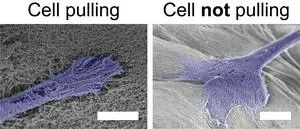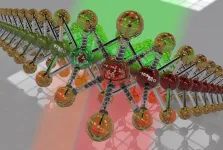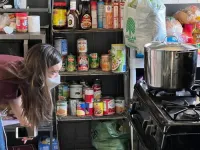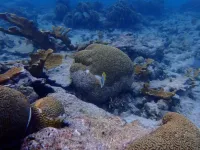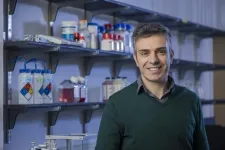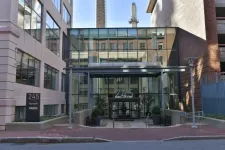(Press-News.org) HOUSTON – (May 3, 2024) – A team of chemists and bioengineers at Rice University and the University of Houston have achieved a significant milestone in their work to create a biomaterial that can be used to grow biological tissues outside the human body. The development of a novel fabrication process to create aligned nanofiber hydrogels could offer new possibilities for tissue regeneration after injury and provide a way to test therapeutic drug candidates without the use of animals.
The research team, led by Jeffrey Hartgerink, professor of chemistry and bioengineering, has developed peptide-based hydrogels that mimic the aligned structure of muscle and nerve tissues. Alignment is critical for the tissues’ functionality, but it is a challenging feature to reproduce in the lab, as it entails lining up individual cells.
For over ten years, the team has been designing multidomain peptides (MDPs) that self-assemble into nanofibers. These resemble the fibrous proteins found naturally in the body, much like a spiderweb at nanoscale.
In their latest study, published online and featured on the cover of the journal ACS Nano, the researchers discovered a new method to create aligned MDP nanofiber “noodles.” By first dissolving the peptides in water and then extruding them into a salty solution, they were able to create aligned peptide nanofibers – like twisted strands of rope smaller than a cell. By increasing the concentration of ions, or salt, in the solution and repeating the process, they achieved even greater alignment of the nanofibers.
“Our findings demonstrate that our method can produce aligned peptide nanofibers that effectively guide cell growth in a desired direction,” explained lead author Adam Farsheed, who recently received his Ph.D. in bioengineering from Rice. “This is a crucial step toward creating functional biological tissues for regenerative medicine applications.”
One of the key findings of the study was an unexpected discovery: When the alignment of the peptide nanofibers was too strong, the cells no longer aligned. Further investigation revealed that the cells needed to be able to “pull” on the peptide nanofibers to recognize the alignment. When the nanofibers were too rigid, the cells were unable to exert this force and failed to arrange themselves in the desired configuration.
“This insight into cell behavior could have broader implications for tissue engineering and biomaterial design,” said Hartgerink. “Understanding how cells interact with these materials at the nanoscale could lead to more effective strategies for building tissues.”
Additional study co-authors from Rice include chemistry department Ph.D. graduates Tracy Yu and Carson Cole, graduate student Joseph Swain, and undergraduate researcher Adam Thomas. Bioengineering undergraduate researcher Jonathan Makhoul, graduate student Eric Garcia Huitron, and Professor K. Jane Grande-Allen were also co-authors on the study. The team of researchers from the University of Houston includes Ph.D. student Christian Zevallos-Delgado, research assistant Sajede Saeidifard, research assistant professor Manmohan Singh and engineering professor Kirill Larin.
This work was supported in part by grants from the National Institutes of Health (R01DE021798, R01EY022362, R01HD095520, R01EY030063), the National Science Foundation (2129122), the National Science Foundation Graduate Research Fellowship Program, and the Welch Foundation (C-2141). The content in this news release is solely the responsibility of the authors and does not necessarily represent the official views of the funding organizations.
-30-
This news release can be found online at news.rice.edu.
Follow Rice News and Media Relations via Twitter @RiceUNews.
Peer-reviewed paper:
Tunable macroscopic alignment of self-assembling peptide nanofibers | ACS Nano | DOI: 10.1021/acsnano.4c02030
Authors: Adam Farsheed, Christian Zevallos-Delgado, Tracy Yu, Sajede Saeidifard, Joseph Swain, Jonathan Makhoul, Adam Thomas, Carson Cole, Eric Garcia Huitron, Kathryn Jane Grande-Allen, Manmohan Singh, Kirill Larin and Jeffrey Hartgerink
https://doi.org/10.1021/acsnano.4c02030
Video is available at:
https://www.youtube.com/watch?v=M4KNgNZi-YI
Description: Aligned peptide “noodle” fabrication process.
Image downloads:
https://news-network.rice.edu/news/files/2024/05/Fig1-0a8c0263b96fee0b.jpg
CAPTION: Scanning electron micrographs of MDP nanofibers of increasing alignments (scale bars = 500 nanometers). (Image courtesy of Adam Farsheed/Rice University)
https://news-network.rice.edu/news/files/2024/05/Fig2-74d0049e3af4946e.jpg
CAPTION: Confocal micrographs of cells spreading on aligned MDP “noodles.” Cell nuclei are stained blue and actin is stained green (scale bar = 500 micrometers). (Image courtesy of Adam Farsheed/Rice University)
https://news-network.rice.edu/news/files/2024/05/Fig3-76ea1c8e19a585f8.jpg
CAPTION: Scanning electron micrographs of cells pulling on nanofibers with lower alignments, but not pulling on nanofibers with higher alignments. Cells are falsely colored blue (scale bars = 5 micrometers). (Image courtesy of Adam Farsheed/Rice University)
https://news-network.rice.edu/news/files/2024/05/Hartgerink_Farsheed-4e1d94d16605710b.jpg
CAPTION: Jeffrey Hartgerink (left) is a professor of chemistry and bioengineering and associate chair for undergraduate studies. Adam Farsheed is a bioengineering doctoral alum and the lead author on the study. (Photo by Gustavo Raskosky/Rice University)
About Rice:
Located on a 300-acre forested campus in Houston, Rice University is consistently ranked among the nation’s top 20 universities by U.S. News & World Report. Rice has highly respected schools of architecture, business, continuing studies, engineering, humanities, music, natural sciences and social sciences and is home to the Baker Institute for Public Policy. With 4,574 undergraduates and 3,982 graduate students, Rice’s undergraduate student-to-faculty ratio is just under 6-to-1. Its residential college system builds close-knit communities and lifelong friendships, just one reason why Rice is ranked No. 1 for lots of race/class interaction, No. 2 for best-run colleges and No. 12 for quality of life by the Princeton Review. Rice is also rated as a best value among private universities by Kiplinger’s Personal Finance.
END
Aligned peptide ‘noodles’ could enable lab-grown biological tissues
Rice discovery represents ‘crucial step’ for tissue engineering
2024-05-03
ELSE PRESS RELEASES FROM THIS DATE:
Law fails victims of financial abuse from their partner, research warns
2024-05-03
Victims of financial abuse from their partner in England and Wales are being failed by an “inadequate” legal response, new research warns.
Coerced debt causes considerable harm. People often live with the effects of being forced to give money or take out loans or credit cards long after the abusive relationship has ended.
Using the law to tackle it is more complex than other forms of abuse because to be free of the harmful effects of the abuse people’s contractual liability for the debt may need to be set aside. The law often favours lenders, who have little obligation to ensure that transactions are free from coercion.
New research recommends ...
Mental health first-aid training may enhance mental health support in prison settings
2024-05-03
According to Rutgers Health researchers, training correctional officers in Mental Health First Aid (MHFA) for adults, a 7.5-hour national education program from the National Council of Mental Wellbeing, may help provide them with the necessary skills to effectively identify signs and symptoms of mental distress and advocate for incarcerated individuals facing mental health crises.
Led by Pamela Valera, an assistant professor in the Department of Urban-Global Public Health at Rutgers School of Public Health, ...
Tweaking isotopes sheds light on promising approach to engineer semiconductors
2024-05-03
Research led by scientists at the Department of Energy’s Oak Ridge National Laboratory has demonstrated that small changes in the isotopic content of thin semiconductor materials can influence their optical and electronic properties, possibly opening the way to new and advanced designs with the semiconductors.
Partly because of semiconductors, electronic devices and systems become more advanced and sophisticated every day. That’s why for decades researchers have studied ways to improve semiconductor compounds to influence how they carry electrical current. One approach is to use isotopes to ...
How E. coli get the power to cause urinary tract infections
2024-05-03
Through a quirk of anatomy, women are especially prone to urinary tract infections, with almost half dealing with one at some point in their lives.
Scientists have been trying to figure out for decades how bacteria gain a foothold in otherwise healthy people, examining everything from how the microbes move inside and stick to the inside of the bladder to how they deploy their toxins to produce uncomfortable and often painful symptoms.
Research published in PNAS examines how the bacteria Escherichia coli, or E. coli—responsible for most UTIs—is able to use host nutrients to reproduce at an extraordinarily rapid pace during ...
Quantifying U.S. health impacts from gas stoves
2024-05-03
Households with gas or propane stoves regularly breathe unhealthy levels of nitrogen dioxide, a study of air pollution in U.S. homes found.
“I didn’t expect to see pollutant concentrations breach health benchmarks in bedrooms within an hour of gas stove use, and stay there for hours after the stove is turned off,” said Stanford Doerr School of Sustainability Professor Rob Jackson, senior author of the May 3 study in Science Advances. Pollution from gas and propane stoves isn’t just an issue for cooks or people in the kitchen, ...
Physics confirms that the enemy of your enemy is, indeed, your friend
2024-05-03
Most people have heard the famous phrase “the enemy of my enemy is my friend.”
Now, Northwestern University researchers have used statistical physics to confirm the theory that underlies this famous axiom.
The study will be published on May 3 in the journal Science Advances.
In the 1940s, Austrian psychologist Fritz Heider introduced social balance theory, which explains how humans innately strive to find harmony in their social circles. According to the theory, four rules — an enemy of an enemy is a friend, a friend of a ...
Stony coral tissue loss disease is shifting the ecological balance of Caribbean reefs
2024-05-03
The outbreak of a deadly disease called stony coral tissue loss disease is destroying susceptible species of coral in the Caribbean while helping other, “weedier” organisms thrive — at least for now — according to a new study published today in Science Advances.
Researchers say the drastic change in the region’s population of corals is sure to disrupt the delicate balance of the ecosystem and threaten marine biodiversity and coastal economies.
“Some fast-growing organisms, like algae, ...
Newly discovered mechanism of T-cell control can interfere with cancer immunotherapies
2024-05-03
Activated T cells that carry a certain marker protein on their surface are controlled by natural killer (NK) cells, another cell type of the immune system. In this way, the body presumably curbs destructive immune reactions. Researchers from the German Cancer Research Center (DKFZ) and the University Medical Center Mannheim (UMM) now discovered that NK cells can impair the effect of cancer therapies with immune checkpoint inhibitors (ICI) in this way. They could also be responsible for the rapid decline of therapeutic CAR-T cells. Interventions in this mechanism could ...
Wistar scientists discover new immunosuppressive mechanism in brain cancer
2024-05-03
PHILADELPHIA — (May 3, 2024) — The Wistar Institute assistant professor Filippo Veglia, Ph.D., and team, have discovered a key mechanism of how glioblastoma — a serious and often fatal brain cancer — suppresses the immune system so that the tumor can grow unimpeded by the body’s defenses. The lab’s discovery was published in the paper, “Glucose-driven histone lactylation promotes the immunosuppressive activity of monocyte-derived macrophages in glioblastoma,” in the journal Immunity.
“Our study shows that the cellular mechanisms of cancer’s self-preservation, when sufficiently understood, can be used against the disease very effectively,” ...
ADA Forsyth ranks number 1 on the East Coast in oral health research
2024-05-03
Cambridge, Mass., – ADA Forsyth Institute (AFI) researchers received just under $10 million funding from the National Institute of Dental and Craniofacial Research (NIDCR) during the federal fiscal year 2023, placing 4th nationally on NIDCR’s ranking list.
“We have ranked in the top 5 dental institutions in 9 out of the past 10 years,” said Wenyuan Shi, PhD, Chief Executive Officer of AFI. “We have placed in the top 10 nationally every year since the ranking system began in 2002, despite having one of the smallest faculty ...
LAST 30 PRESS RELEASES:
Chonnam National University researchers propose innovative voltage-loop control for power factor correction
Accelerating next-generation drug discovery with click-based construction of PROTACs
Detecting the hidden magnetism of altermagnets
$7M gift supports health research, engineering and athletics at UT San Antonio
NU-9 halts Alzheimer’s disease in animal model before symptoms begin
Hospitals acquired by real estate investment trusts associated with greater risk of bankruptcy, closure
City of Hope scientists study rare disorder to uncover mechanism and hormone regulation underlying fatty liver disease and sweet aversion
Your genes may influence gut microbiome of others, rat study shows
‘Personality test’ shows how AI chatbots mimic human traits – and how they can be manipulated
Global food systems driving twin crises of obesity and global heating
Osaka Medical and Pharmaceutical University researchers capture real-time molecular movies of enzyme catalysis
Could your genes influence the gut microbiome of others?
Clues to Alzheimer’s disease may be hiding in our ‘junk’ DNA
Study reveals that the body uses different sensors to detect cold in the skin and in internal organs
iPS cells from dish to freezer and back
Deep neural networks enable accurate pricing of American options under stochastic volatility
Collective risk resonance in Chinese stock sectors uncovered through higher-order network analysis
Does CPU impact systemic risk contributions of Chinese sectors? Evidence from mixed frequency methods with asymmetric tail long memory
General intelligence framework to predict virus adaptation based on a genome language model
Antibiotic resistance is ancient, ecological, and deeply connected to human activity, new review shows
Vapes, pouches, heated tobacco, shisha, cigarettes: nicotine in all forms is toxic to the heart and blood vessels
From powder to planet: University of Modena engineers forge a low-carbon future for advanced metal manufacturing
Super strain-resistant superconductors
Pre-school health programme does not improve children’s diet or physical activity, prompting call for policy changes, study finds
Autumn clock change linked to reduction in certain health conditions
AI images of doctors can exaggerate and reinforce existing stereotypes
Where medicine meets melody – how lullabies help babies and parents in intensive care
We may never be able to tell if AI becomes conscious, argues philosopher
AI video translation shows promise but humans still hold the edge
Deep ocean earthquakes drive Southern Ocean’s massive phytoplankton blooms, study finds
[Press-News.org] Aligned peptide ‘noodles’ could enable lab-grown biological tissuesRice discovery represents ‘crucial step’ for tissue engineering


